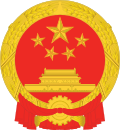History
The Supreme People's Court was established on 22 October 1949 [4] and began operating in November 1950. [5] : 146 At least four members of the first court leadership did not come from a legal background, and most of its first staff were assigned from the People's Liberation Army to the Court. [5] : 146 The functions of the court was first outlined in the Chinese constitution in its 1954 version, which said the court has the power of independent adjudication and is accountable to the National People's Congress. [6] : 76–77
During the Cultural Revolution, the 1975 constitution removed the provision that said courts were to decide cases independently and required them to report to revolutionary committees. [6] : 77 Most staff members of the court were sent to the countryside, and the People's Liberation Army occupied the court from 1968 to 1973. [5] : 147
Following the end of the Cultural Revolution in 1976, the Supreme People's Court began to focus on legal issues, especially those related to civil and commercial law, because of China's reform and opening up under new leader Deng Xiaoping. [5] : 147 The independent power of adjudicate cases returned to the constitution with the 1982 amendment, which explicitly states the courts' right of adjudication cannot be influenced by administrative organs, social organizations and individuals. [6] : 77
In 2005, the Supreme People's Court announced its intent to "[take] back authority for death penalty approval" over concerns about "sentencing quality", [7] and the National People's Congress officially changed the Organic Law on the People's Courts to require all death sentences to be approved by the Supreme People's Court on 31 October 2006. [8] A 2008 report stated that since the new review process, the court has rejected 15 percent of the death sentences decided by lower courts. [9]
As part of an effort to build judicial credibility through more effective enforcement of court orders, the SPC in 2013 promulgated a blacklist composed of Chinese citizens and companies that refuse to comply with court orders (typically court orders to pay a fine or to repay a loan) despite having the ability to do so. [10] : 53 As of 2023, the SPC's blacklist is one of its most important enforcement tools and its use has resulted in the recovery of tens of trillions of RMB for fines and delinquent repayments. [10] : 53
On 1 January 2019, the Intellectual Property Tribunal of the Supreme People's Court was established to handle all second instance hearings from cases heard in the first instance by the Intellectual Property Courts. [11]
Functions
According to the Constitution of China, the Supreme People's Court is accountable to the National People's Congress. [12] [13] : 14 It is also subservient to the Chinese Communist Party (CCP). [14] The court has about 400 judges and more than 600 administrative personnel. [13] : 16
Adjudication
The Supreme People's Court exercises its original jurisdiction over cases placed with the court by laws and regulations and those the court deems within its jurisdiction. It is generally selective in the matters it hears, focusing on those with the potential to impact future similar cases. [15] : 63 It also reviews appeals or protests against trial decisions or verdicts of high people's courts and special people's courts, as well as appeals against court judgments lodged by the Supreme People's Procuratorate according to trial supervision procedures. When the court has discovered errors in the rulings and verdicts of lower courts that are already enforced, it investigates or appoints a lower court to rehear the case.
The court also approves death sentences and suspended death sentences handed down by lower courts. It also approves verdicts on crimes not specifically stipulated in the criminal law.
Legal interpretation
The court explains the application of laws in specific cases during a trial. [16] Further details about this were described by Zhou Qiang as:
The reply is a request for a specific case. Its legal binding force is limited to the case itself and does not have universal legal effect. In other cases, the judge cannot directly use the above reply as the basis for the judgment. For documents that have universal effectiveness and guide courts at all levels, the Supreme People's Court generally publishes it in the form of judicial interpretation and can make inquiries in newspapers and on the Internet. [17]
While the Chinese constitution does not state that courts have the power to review laws for their constitutionality (see constitutional review), the Supreme People's Court can request the Standing Committee of the National People's Congress to evaluate whether an administrative rule, local regulation, autonomous regulation or separate regulation contravenes the constitution or a national law. [6] : 74 However, the Supreme People's Court has never made such request. [6] : 78
Supervision of lower courts
The Supreme People's Court is also responsible for supervising the adjudication of lower courts and specialized courts. [6] : 71
This page is based on this
Wikipedia article Text is available under the
CC BY-SA 4.0 license; additional terms may apply.
Images, videos and audio are available under their respective licenses.




